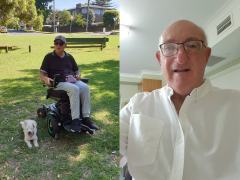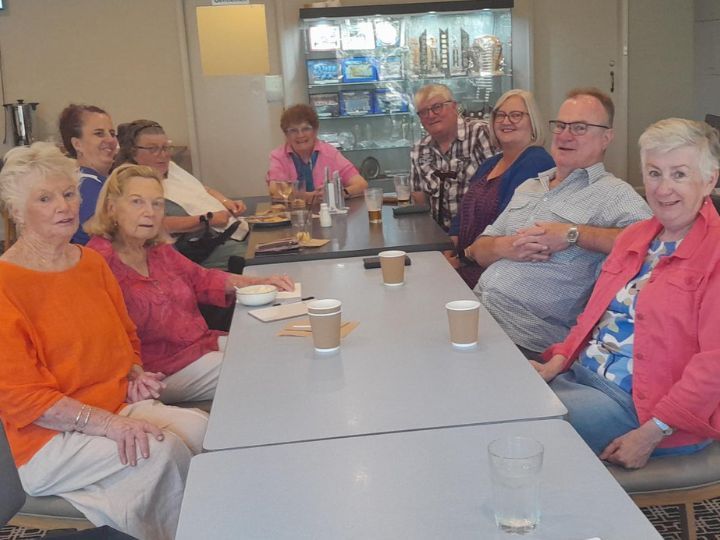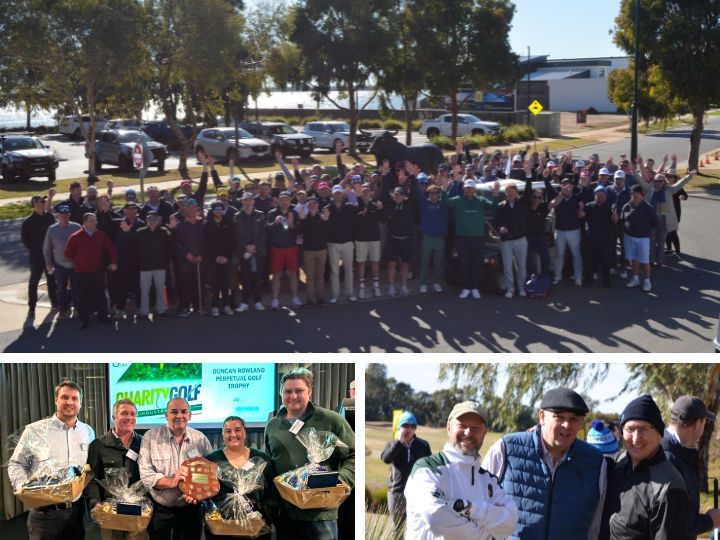It isn’t every day that you turn your experience of a life-changing diagnosis into a guide that gets published in one of the world’s most prestigious medical journals, and which could assist people globally.
But that’s exactly what Richard Sleeman, sports reporter and person living with MND, did.
Richard was diagnosed with MND in 2013. For many people with MND, average life expectancy is unfortunately only a couple of years following diagnosis.
Thankfully, Richard is ‘incredibly lucky to be a decade living with MND and still active’, and we at MND NSW are glad to be able to support him on his MND Journey.
“You might see me whizzing round the corridors of Montefiore, Hunters Hill, and surrounding streets at breakneck speed in my chilli-red wheelchair. Long may it continue,” he said.
He always felt it was important for him to leave a legacy, to do his bit to make life easier and longer for those still to be diagnosed with MND. His profession as a ‘humble sportswriter’ meant he had the written word in his bag of skills, and lived MND experience.
Richard was concerned that he battled along with various symptoms for 18 long months without a diagnosis.
Because MND is an uncommon condition, most GPs and physios never encounter it. So, when he tried to rush to catch public transport and couldn’t, or began dropping things increasingly often, he was simply told it was a normal part of ageing, or a touch of arthritis.
“The first indication for me of what would much later be an MND diagnosis was trying to run for the train. I was suddenly frozen, unable to put one foot in front of the other, like in the common nightmare: being chased, but stuck there,” Richard said.
“As it happened more often, I sought advice from GPs—four in six months. I was told it was just old age or arthritis: get some physiotherapy, here are some anti-inflammatories. I was 62,” he said.
“Only when I saw a neurosurgeon on a completely unrelated matter—for a pinched nerve in my neck—was something more sinister suspected. He was concerned about my right foot shuffle and shake, ordered a brain scan, and made a neurology appointment. There I was told: “I think I know what it is. You’ll need tests. Are you stoic?”
Unfortunately, for many people the process for being diagnosed with MND is a lengthy one, as Richard found.
Research has found up to two thirds of patients with symptoms are told they have another condition before
eventually being diagnosed with ALS. For those who were initially diagnosed with ALS, only 6% will go on to receive an alternative diagnosis to explain the symptoms they experienced.
The 2020 Gold Coast diagnostic criteria that is now being used by many practitioners has a sensitivity greater than 90% for diagnosing ALS. This updated diagnostic criteria could help ensure that an MND/ALS diagnosis is made earlier, improving access to emerging therapies for the condition.
Unfortunately, without the specialist knowledge of a neurologist, identifying these signs and symptoms can still be tricky for primary care clinicians who rarely see such cases.
Until such time as analysis of biomarkers can be reliably used in clinical settings, people experiencing symptoms suggestive of MND/ALS rely on their primary healthcare professionals to recognise that it could be ALS.
So, he got to work with his neurologist Dr Colin Mahoney.
Together, they have put together a helpful diagnosis flowchart, based on Dr Mahoney’s extensive knowledge and Richard’s lived experience as a person diagnosed and currently living with ALS.
Dr Mahoney’s solution of a how-to guide for GPs and primary carers to recognise symptoms makes the process simpler, helping clinicians better identify cases
that could be ALS, so patients could get the assistance they need sooner - ‘early diagnosis. That’s the urgent need.’
Richard was ready to draft this guide and make sure to ‘stick it to every wall of every GPs surgery in Sydney.’ However, Dr Mahoney had grander plans, and after a lot of hard work, their guide was published in the British Medical Journal.
With around 85% of MND cases being ALS, the type Richard has, and the incidence expected to increase by 30% by 2040, better guidelines to help primary healthcare professionals identify potential MND and ALS cases earlier are crucial.
International guidelines, including those from the US and Europe, emphasise the need for early recognition and priority referral to an experienced centre for assessment.
By getting onto a suspected diagnosis sooner rather than later, this allows early access to disease modifying therapies, clinical trials, and multidisciplinary support, which may improve survival and quality of life for a person living with MND.
Primary care doctors and physiotherapists, as the first point of contact for most people’s healthcare concerns, can be critical in reducing delays.
While there may not currently be an MND cure, Richard feels that getting started early on multi-disciplinary care is vital to extending quality of life and life expectancy.
Richard has heard from many medical experts that the paper and diagnosis flowchart he and Dr Mahoney created has the potential to extend the lives, and quality of life, for tens of thousands of people living with MND globally.




